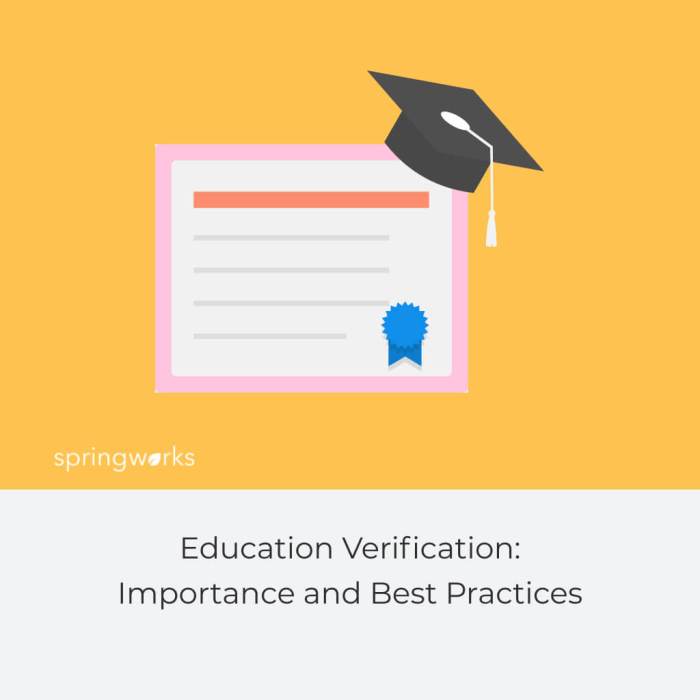
Education verification for employment is becoming increasingly crucial in today’s job market. From official transcripts to online databases, various methods are used to verify educational credentials, reflecting the growing need for accurate and reliable information. This process impacts everything from initial job applications to career advancement, shaping how employers assess candidates and how individuals build credibility. Understanding the nuances of this system is essential for both job seekers and employers.
This exploration delves into the intricacies of education verification, covering everything from different verification methods to global perspectives and the impact on careers. We’ll examine the challenges, innovations, and best practices in this vital process. The goal is to provide a comprehensive understanding of how education verification impacts the employment landscape.
Introduction to Education Verification for Employment
Education verification plays a crucial role in the modern employment process, extending far beyond simply checking if someone attended a school. It’s a critical component of ensuring the authenticity and accuracy of an applicant’s claimed educational background. This verification process helps employers make informed hiring decisions, ensuring they’re recruiting candidates with the skills and knowledge they need for the job.The importance of verifying educational credentials has increased significantly in today’s competitive job market.
Employers are increasingly looking for verifiable proof of qualifications, and they need to be confident that the information provided by applicants is accurate and reliable. This is driven by a desire to reduce fraud, ensure quality, and improve the overall hiring process. Robust verification systems help to maintain a level of trust and transparency within the employment landscape.
Importance of Robust Verification Systems
Robust education verification systems are vital for several reasons. Firstly, they help to reduce instances of fraudulent claims of educational attainment. Secondly, they provide a standardized way to assess the qualifications of candidates, allowing employers to compare candidates more effectively. Finally, they ensure that the qualifications claimed by applicants align with the actual skills and knowledge required for the job.
Different Types of Educational Institutions and their Verification Processes
Educational institutions vary greatly, from traditional universities and colleges to vocational schools and online learning platforms. Verification processes differ depending on the institution and the type of credential. For example, universities often maintain centralized records and issue official transcripts, which are commonly used for verification. Vocational schools, on the other hand, may have specific procedures for verifying certificates or diplomas.
Online learning platforms might use their own internal databases or third-party verification services.
Comparison of Verification Methods
Different methods for verifying educational credentials offer varying degrees of accuracy and efficiency. This table compares three common methods:
| Verification Method | Description | Accuracy | Efficiency | Cost |
|---|---|---|---|---|
| Official Transcripts | Official documents issued directly by the institution, usually containing academic records. | High | Moderate | Variable |
| Online Databases | Centralized databases maintained by accrediting bodies or educational institutions, containing verified records. | High | High | Variable |
| Third-Party Verification Services | Specialized services that verify credentials using multiple sources and provide reports. | High | High | Variable, often higher |
The choice of verification method often depends on factors like the specific requirements of the job, the budget, and the time constraints. For instance, official transcripts offer the highest level of authenticity but may take longer to obtain. Online databases can be very efficient but might not be readily available for all institutions. Third-party services offer a balance between speed and accuracy, but the cost is usually higher.
Methods of Education Verification
Verifying educational credentials is a crucial step in employment processes, ensuring the authenticity and validity of claimed qualifications. This process plays a critical role in maintaining standards and preventing fraud within the job market. Accurate verification also safeguards the reputation of educational institutions and fosters trust in the workforce.Different methods exist for verifying educational credentials, each with its own strengths and weaknesses.
These methods vary based on the type of institution, the location of the degree, and the resources available to the verifier. Understanding these nuances is essential for employers and individuals seeking to verify their credentials.
Methods of Verification
Various methods are employed for verifying educational credentials, each with specific advantages and disadvantages. These methods include direct contact with institutions, online databases, and third-party verification services. The choice of method often depends on factors such as the institution’s policies, the verifier’s resources, and the nature of the credential being verified.
- Direct Contact with Institutions: This method involves contacting the issuing institution directly to request official transcripts or verification of a degree. It provides a high degree of accuracy, as the information comes directly from the source. However, it can be time-consuming and may involve significant administrative overhead, especially for institutions with a high volume of requests.
- Online Databases: Many educational institutions and governmental agencies maintain online databases of verified degrees. This method offers a convenient and potentially faster alternative to direct contact. The availability and comprehensiveness of these databases vary widely. For instance, some institutions may not be included in certain online databases, potentially leading to verification issues.
- Third-Party Verification Services: These services specialize in verifying educational credentials. They often have access to a wider range of institutions’ records and can provide expedited verification services. While these services can save time, they may come with additional costs. The reliability of the service depends on its reputation and the scope of its database.
Examples of Verification in Industries
Different industries apply varying verification methods based on their specific needs. For example, in the healthcare sector, verifying medical degrees is crucial to ensure patient safety. In this industry, direct contact with the issuing institution is often preferred, followed by cross-referencing with online databases to ensure the degree’s legitimacy and compliance with licensing requirements. Conversely, in the tech sector, online databases and third-party services may be favored for their efficiency in verifying technical certifications and software developer qualifications.
Steps in Verifying Degrees
| Institution Type | Steps Involved |
|---|---|
| University (US) | 1. Request official transcript. 2. Verify the institution’s seal and signature. 3. Confirm degree title and dates of attendance. 4. Compare transcript with official records. |
| Community College (US) | 1. Request official transcript. 2. Verify institution’s seal and signature. 3. Confirm degree title and dates of attendance. 4. Compare transcript with official records, possibly with cross-referencing to state/regional databases. |
| Foreign Institution | 1. Verify institution’s accreditation status (if applicable). 2. Translate official documents (if necessary). 3. Obtain official verification of degree from the institution. 4. Use an internationally recognized credential evaluation service for equivalence assessment. |
Security Measures
Security measures vary across different verification methods. Direct contact often involves secure communication channels, and online databases may use encryption protocols. Third-party services implement security measures to protect sensitive information, including data encryption and access controls. The level of security depends on the resources and reputation of the verification method. Verification services with robust security measures generally offer greater assurance to employers.
Challenges and Issues in Education Verification
Education verification, crucial for employment, faces numerous challenges. These obstacles, ranging from technical issues to ethical concerns, can significantly impact the accuracy and reliability of the process. Understanding these challenges is vital for developing robust and trustworthy systems for verifying educational credentials.
Common Challenges and Obstacles
The education verification process is often hampered by a variety of obstacles. These include inconsistencies in record-keeping across different institutions, variations in educational standards, and the sheer volume of data that needs to be processed. Furthermore, outdated or incomplete data within institutional databases can lead to inaccuracies and delays in verification.
- Inconsistent Record-Keeping: Different educational institutions may employ varying methods for recording and storing data. This lack of standardization can make it difficult to compare credentials across institutions, leading to confusion and potentially inaccurate verification results.
- Varied Educational Standards: Educational standards and curricula can differ significantly between institutions, even within the same country. This difference in educational standards makes it difficult to establish uniform benchmarks for verification.
- Data Volume and Processing: The sheer volume of educational records that need to be verified can strain existing systems. Handling this large dataset efficiently and accurately requires robust technology and well-trained personnel.
- Outdated or Incomplete Data: Institutions may have outdated or incomplete data in their databases, which can lead to errors in verification. This problem is particularly relevant for historical records and institutions with limited digitalization efforts.
Potential Risks and Vulnerabilities of Online Systems
Online education verification systems, while offering convenience, introduce specific risks and vulnerabilities. These vulnerabilities include potential data breaches, unauthorized access, and the risk of manipulation or falsification of records. Protecting sensitive data is paramount to maintain the integrity of the verification process.
- Data Breaches: Online systems are susceptible to data breaches, where unauthorized individuals gain access to sensitive educational records. This can compromise the privacy of individuals and lead to the misuse of their information.
- Unauthorized Access: Security measures must be in place to prevent unauthorized access to verification systems. This includes robust authentication protocols and access controls to safeguard data from malicious actors.
- Manipulation and Falsification: Online systems can be susceptible to manipulation or falsification of records. Preventing such fraudulent activities requires sophisticated verification mechanisms and robust data validation processes.
Data Security and Privacy
Data security and privacy are paramount in education verification procedures. Maintaining the confidentiality of personal information, adhering to relevant data protection regulations, and implementing encryption measures are crucial. Failure to prioritize these aspects can have severe consequences.
- Confidentiality of Personal Information: Protecting the confidentiality of personal information related to education verification is critical. Strict adherence to data protection regulations, including anonymization and access controls, is essential.
- Adherence to Data Protection Regulations: Educational verification systems must comply with all relevant data protection regulations, ensuring that data is handled ethically and legally.
- Encryption Measures: Implementing strong encryption measures for data transmission and storage is vital to protect sensitive information from unauthorized access and breaches.
Potential Biases and Inaccuracies in Educational Data
Educational data can reflect existing societal biases, leading to potential inaccuracies in verification. Factors such as socioeconomic status, geographical location, and access to quality education can affect the representation and accuracy of educational records.
- Representation of Societal Biases: Educational data may reflect existing societal biases, leading to skewed or inaccurate representations of educational attainment in certain demographics.
- Impact of Socioeconomic Factors: Socioeconomic status and geographical location can influence access to quality education, potentially affecting the accuracy and representation of educational data.
Fraudulent Activity and Preventive Measures
Fraudulent activities, such as the creation of fake credentials, can compromise the integrity of the verification process. Implementing robust authentication mechanisms, conducting regular audits, and fostering transparency can help mitigate these risks.
- Creation of Fake Credentials: Fraudulent actors may create fake educational credentials to gain employment or other advantages. Preventing this requires careful verification procedures.
- Robust Authentication Mechanisms: Implementing strong authentication methods, such as multi-factor authentication, can help prevent unauthorized access and the creation of fraudulent credentials.
- Regular Audits and Transparency: Regular audits of the verification system and transparency in the verification process can help identify and prevent fraudulent activities.
Technological Advancements and Innovations

Technology is rapidly transforming the landscape of education verification, offering more efficient, accurate, and secure methods. These advancements are crucial for streamlining the employment verification process, ensuring the authenticity of credentials, and ultimately, reducing fraud and enhancing trust. The incorporation of technology promises to resolve many of the challenges associated with traditional verification methods, thereby improving the overall experience for both employers and candidates.Technological advancements are impacting education verification in several key ways.
Ever wondered how verifying your education for a job can be so crucial? It’s a vital part of the employment process, ensuring qualifications match advertised roles. Speaking of verifying credentials, did you know that high-tech flashlights could turn you into a collector? High tech flashlights could turn you into a collector The sheer variety and functionality available are truly impressive.
Ultimately, though, education verification remains a key element for career advancement and finding the right opportunities.
From streamlining the process to enhancing security, these tools are playing an increasingly important role in modern hiring practices. These improvements are enabling a faster and more secure method of verifying qualifications, leading to a more efficient and trustworthy employment process.
Education verification for employment can be a real pain, let’s be honest. It’s often a necessary evil, but the whole process can feel like a bureaucratic nightmare. Sometimes, you just want to scream “whine whine whine oh rats!” whine whine whine oh rats about the endless forms and hoops you have to jump through. But, in the end, verifying your education is a crucial step for getting the job you want.
Role of Technology in Enhancing Education Verification
Technology plays a pivotal role in enhancing education verification by automating tasks, improving accuracy, and increasing security. This is achieved through the integration of various digital tools and platforms, which provide a secure and reliable method of verifying credentials. This approach ensures that employers have access to authentic and verifiable information about a candidate’s educational background.
Examples of Emerging Technologies Used for Verification, Education verification for employment
Several emerging technologies are being implemented to enhance education verification. Digital platforms allow for the secure storage and retrieval of educational records, while sophisticated algorithms can analyze data for potential inconsistencies. This automation significantly reduces the time and resources required for manual verification.
- Digital Portals and Platforms: Many institutions now maintain online repositories of student records. These portals offer secure access to transcripts and other academic documentation, enabling employers to verify degrees and qualifications directly. This digital approach eliminates the need for physical documents, enhancing efficiency and reducing delays.
- Mobile Applications: Mobile applications facilitate easy access to verification information for both employers and candidates. These applications can directly connect to institutional databases, providing real-time verification and reducing the time needed for the entire process.
Blockchain Technology for Improved Accuracy and Security
Blockchain technology, known for its immutability and transparency, can significantly improve the accuracy and security of education verification processes. By creating a tamper-proof record of academic achievements, blockchain can reduce the risk of fraudulent credentials.
- Immutable Records: Blockchain’s decentralized nature ensures that academic records are stored securely and cannot be altered or deleted. This characteristic makes it virtually impossible to fabricate or falsify academic credentials.
- Enhanced Transparency: The transparent nature of blockchain allows all parties involved to verify the authenticity of educational records. This transparency builds trust and confidence in the verification process.
AI and Machine Learning in Automating Verification Tasks
Artificial intelligence (AI) and machine learning (ML) are revolutionizing the automation of education verification tasks. AI-powered systems can analyze large datasets of educational records, identify patterns, and flag potential inconsistencies, thereby enhancing the accuracy and efficiency of the verification process.
- Automated Data Analysis: AI algorithms can process large volumes of data from educational records, detecting anomalies and inconsistencies that might indicate fraudulent activities. This automated analysis significantly reduces the workload for manual reviewers.
- Predictive Modeling: Machine learning models can be trained on historical data to identify potential fraudulent patterns. This capability enables proactive identification and prevention of fraudulent credentials.
Digital Identity Solutions for Enhanced Verification
Digital identity solutions are emerging as a powerful tool for streamlining the education verification process. These solutions provide a secure and standardized method of verifying an individual’s identity and educational background.
Ensuring accurate education verification for employment is crucial, especially in today’s job market. Think about how vital reliable credentials are. Security sleuths work overtime to confound conficker, like this article details , highlighting the ongoing battle against fraud. Ultimately, robust verification systems protect employers and job seekers from scams, guaranteeing authenticity and trust in the employment process.
- Secure Verification: Digital identity solutions often leverage multi-factor authentication and encryption to protect the privacy and security of educational records. This ensures that only authorized individuals can access the information.
- Standardized Verification: These solutions create a standardized framework for verifying credentials, which reduces the complexity and time associated with diverse verification methods. This approach ensures consistency and accuracy.
Global Perspectives on Education Verification
Navigating the global job market requires understanding the diverse approaches to verifying educational credentials. Different countries have unique systems for documenting and validating educational achievements, leading to complexities in cross-border employment. This necessitates a global perspective to ensure fair and efficient recognition of qualifications.The global landscape of education verification is marked by significant variations in procedures, standards, and legal frameworks.
These differences often pose challenges for individuals seeking employment across borders. Standardization efforts aim to streamline this process, but significant disparities persist, demanding a nuanced understanding of the specific requirements in each region.
Varied Education Verification Procedures Across Countries
Different countries employ distinct methods for verifying educational credentials. Some rely heavily on official transcripts and certificates, while others utilize national databases or specialized agencies. This variation creates a complex web of requirements that candidates must navigate when applying for international employment. For instance, some nations prioritize standardized tests for specific professions, while others may rely on employer-conducted assessments.
Recognizing and complying with these differing approaches is critical for successful international job applications.
International Standards and Regulations
International organizations play a crucial role in promoting harmonization of education verification practices. The UNESCO, for example, advocates for international standards in recognizing qualifications, facilitating cross-border recognition. However, the practical implementation of these standards varies significantly from country to country, highlighting the ongoing challenge in achieving a globally uniform approach. Efforts to establish common frameworks are ongoing, with the aim of simplifying the verification process for individuals seeking employment abroad.
Legal Frameworks for Education Verification
Legal frameworks governing education verification differ significantly across regions. Some countries have robust legal provisions outlining the procedures for validating educational credentials, while others rely on less formalized systems. This variation affects the validity and acceptance of qualifications in different jurisdictions. A thorough understanding of the specific legal requirements in each country is vital for ensuring the acceptance of credentials.
For instance, the European Union has established a framework for the recognition of qualifications within its member states, demonstrating a more harmonized approach compared to other regions.
Impact of Globalization on Standardized Verification Methods
Globalization has intensified the need for standardized education verification methods. The increasing mobility of individuals for work and education necessitates a more streamlined and universally recognized system for validating credentials. This is particularly true for professions requiring specific qualifications, such as engineering, medicine, or law. The rising demand for skilled labor globally necessitates the adoption of common standards to ensure fair competition and facilitate the movement of qualified professionals across borders.
Challenges Faced by Individuals Seeking Employment Across Borders
Individuals seeking employment across borders face numerous challenges related to education verification. These challenges include the cost and time associated with document translations and verification processes. Moreover, differences in academic standards and curricula between countries can make it difficult to demonstrate equivalency. Individuals may also encounter cultural barriers or lack awareness of the specific requirements in their target countries.
These difficulties highlight the necessity of improved communication and collaboration between educational institutions and employment sectors globally.
Best Practices for Education Verification: Education Verification For Employment

Ensuring the accuracy and validity of educational credentials is crucial for both employers and employees. Robust verification processes not only protect against fraud but also build trust in the labor market. Implementing best practices safeguards against costly mistakes and legal issues, while fostering a fairer and more transparent hiring process.Effective verification strategies go beyond simply checking transcripts. They encompass a multi-faceted approach, focusing on security, efficiency, and ethical considerations.
This approach helps both employers and employees to confidently navigate the education verification landscape.
Best Practices for Verifying Educational Credentials
Verification procedures should incorporate multiple layers of scrutiny to minimize the risk of fraudulent claims. This involves cross-referencing information from multiple sources and employing rigorous validation techniques. The goal is to ensure that the presented credentials accurately reflect the candidate’s educational achievements. Key elements in a robust verification process include verifying the institution’s legitimacy, confirming the degree’s authenticity, and checking for any discrepancies in the presented data.
Designing a Secure and Efficient Verification Process
A flowchart illustrating a secure and efficient verification process would begin with the employer initiating the request. The system should then automatically check for the existence of the institution in a recognized database of accredited educational institutions. Following this, the system should access the institution’s official records. Finally, it should compare the candidate’s information with the institution’s records, and if there are any discrepancies, it should alert the employer to investigate further.
 This flowchart visually demonstrates a secure and efficient verification process. It begins with an employer request and proceeds through automated checks to verify the institution’s accreditation and compare candidate data with institutional records. Any discrepancies are flagged for further investigation.
This flowchart visually demonstrates a secure and efficient verification process. It begins with an employer request and proceeds through automated checks to verify the institution’s accreditation and compare candidate data with institutional records. Any discrepancies are flagged for further investigation.
Ensuring Data Accuracy and Preventing Fraudulent Activity
Ensuring data accuracy is paramount. A crucial step is to establish clear protocols for data collection, storage, and access control. This involves implementing stringent security measures to protect sensitive information and using robust authentication systems to prevent unauthorized access. Regular audits and internal reviews can further identify and correct potential errors. A critical element is the implementation of robust fraud detection systems that can identify anomalies and inconsistencies in submitted data.
Examples of Institutions Implementing Effective Verification Strategies
Many institutions have developed innovative solutions for education verification. Some utilize secure online portals that allow for direct verification of credentials. Others have partnered with third-party verification agencies to streamline the process. Examples include universities that have implemented online systems for transcript delivery and verification. These strategies demonstrate that effective verification is achievable through technological advancements and collaboration.
Key Considerations for Employers and Employees Regarding Verification
- Employers should establish clear verification policies that meet legal and ethical standards. They should also use multiple verification methods to ensure accuracy and prevent fraud. Employers should communicate these policies transparently to candidates during the hiring process.
- Employees should maintain accurate records of their educational achievements and ensure that their credentials are readily available for verification. Employees should understand and adhere to the verification procedures established by employers and institutions.
Impact on Employment and Careers
Education verification is no longer a simple administrative task; it’s a pivotal factor in shaping modern employment landscapes. The process directly impacts individuals’ career trajectories, from initial job applications to long-term career advancement. Its influence on recruitment processes and hiring decisions is profound, fostering a more transparent and trustworthy environment for both employers and job seekers.The impact of verified credentials extends beyond simple validation.
It fosters a culture of trust and credibility, making the hiring process more efficient and reducing the risk of fraudulent claims. This, in turn, allows employers to make more informed decisions and select candidates who genuinely possess the skills and knowledge they require.
Impact on Employment Opportunities
Verification processes significantly impact employment opportunities by increasing the trustworthiness and reliability of information presented by candidates. This leads to fairer competition, where individuals’ skills and qualifications are accurately assessed. Improved accuracy in candidate assessments, in turn, empowers recruiters to make well-informed decisions, aligning candidates with suitable roles and maximizing workforce potential.
Role of Verified Credentials in Building Trust and Credibility
Verified credentials play a crucial role in building trust and credibility in the employment landscape. They provide a transparent and verifiable record of educational achievements, experience, and skills, reducing the scope for misrepresentation. This enhanced transparency, supported by robust verification processes, empowers employers to confidently assess candidates, leading to a more efficient and effective hiring process.
Examples of Enhanced Career Prospects
Verified credentials can significantly enhance career prospects by providing concrete evidence of qualifications and achievements. For example, a software developer with verified certifications in specific programming languages can more easily secure roles requiring those particular skills. This transparency translates into a more competitive advantage for candidates and often results in higher salaries and better career opportunities.
Correlation Between Education Verification and Career Advancement
Education verification and career advancement are intrinsically linked. A verifiable record of education and training often acts as a stepping stone to more challenging and rewarding roles. Individuals with verified credentials can demonstrate a continuous commitment to professional development and skill enhancement, which frequently translates into greater career advancement potential.
Impact on Recruitment Processes and Hiring Decisions
Verification processes transform recruitment processes, moving away from reliance on potentially inaccurate information. Hiring decisions become more objective and data-driven, based on verifiable credentials and demonstrable skills. This shift towards a more transparent and accurate assessment system allows for more informed hiring decisions, ultimately benefiting both the employer and the candidate. Verified credentials empower recruiters to quickly and efficiently identify suitable candidates and reduce the time spent on less qualified applications.
Outcome Summary
In conclusion, education verification for employment is a multifaceted process, evolving with technology and global trends. While challenges remain, robust verification methods are essential for building trust and ensuring accuracy in the job market. Understanding the process, from the various methods to the global considerations, is key for both employers and job seekers. The future of employment hinges on a reliable system of education verification.






